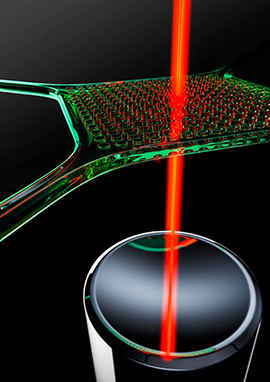
The quantum absurdity that leads to the notion of Schrodinger's cat — in which a cat can exist in two states simultaneously — could finally be tested in an object visible to the naked eye, a new study demonstrates.
Scientists have created a pendulum-like membrane that is so perfectly isolated from friction and heat "that it would just keep going for 10 years with a single push," said study co-author Simon Gröblacher, a physicist at Delft University of Technology in the Netherlands. "If you create a quantum state in this object, it will not go away."
This tiny, flea-size swing could allow scientists to finally test whether the quantum effects behind the Schrodinger's cat thought experiment do indeed exist at large scales. [How Quantum Entanglement Works]
Cat in trouble
In 1936, physicist Erwin Schrödinger proposed a now-famous thought experiment meant to highlight the bizarre implications of quantum mechanics. In his formulation, a cat is trapped in a box with a radioactive atom. If that atom decays, the cat will be poisoned and die, but if the atom has not decayed, the cat lives.
The so-called Copenhagen interpretation of quantum mechanics implied that the radioactive atom is in two states at once, simultaneously decayed and undecayed, until some brave soul opens the box and measures or perturbs the atom. By extension, the cat would be both dead and alive at the same time, until the box was opened.
The weird phenomenon, known as superposition, has been demonstrated time and again with tiny, subatomic particles. Yet scientists have never observed a cat, or any visible object, that was simultaneously in two states or places at once.
Exactly why isn't clear, but scientists have a few hypotheses. One is that the laws of quantum mechanics simply break down at larger scales.
Sign up for the Live Science daily newsletter now
Get the world’s most fascinating discoveries delivered straight to your inbox.
However, that would mean current quantum theory is incomplete, Gröblacher said.
"Quantum theory itself doesn't have any mass or size limit," at which its laws stop working, Gröblacher told Live Science.
Most scientists instead believe that superposition is ephemeral; perturb it just a bit, and the whole state collapses. As objects get larger, they are much more likely to exchange heat with the environment, disturbing this delicate state.
But hypothetically, at least, even very large objects could display these quantum effects, assuming you could isolate the objects well enough from their environments.
Cloistered environment
To create such a cloistered quantum object, Gröblacher and his colleagues used a relatively simple mechanical design: a small membrane that acts similar to a pendulum, placed inside a vacuum, so no heat can be exchanged with the environment. The membrane itself looks a bit like a paddle tethered at the ends by two tiny points of contact. Though it is about 0.04 inches (1 millimeter) long, it is also exquisitely thin, just "eight times the thickness of DNA," Gröblacher said.
The tiny tether points are also essentially the only spots at which this membrane interacts with the environment. The material itself, called silicon nitride, is used as a coating inside spacecraft components, and can sustain incredibly high internal stress. The high stress in the pendulum provides the internal stored energy needed to propel the near-perpetual swinging.
The team then etched a pattern on the surface of the teensy object, turning it into a supermirror that reflects almost all of the incoming light particles. As such, the membrane absorbs almost no heat, which would disturb fragile quantum effects. This incredible reflectivity allowed the researchers to run their system at room temperature, whereas past systems relied on supercold setups just a few degrees away from absolute zero (the lowest possible temperature).
The team then hit the quantum membrane with laser light. Sure enough, it reflected almost all the lifht. The membrane was so well-isolated from the environment that the researchers believe it can illustrate the weird quantum phenomenon called superposition; with the pendulum essentially in two swing positions simultaneously, the researchers reported in April in the journal Physical Review Letters.
The new device is finally good enough that researchers could detect large-scale quantum effects, Gröblacher said, adding that the jury is still out on the question of why such effects are generally not seen at larger scales.
"What mechanisms destroy quantum physics in large objects: That's an open question," Groblacher said. "There are a bunch of theories. We're just trying to disprove and test these theories."
Original article on Live Science.

Tia is the managing editor and was previously a senior writer for Live Science. Her work has appeared in Scientific American, Wired.com and other outlets. She holds a master's degree in bioengineering from the University of Washington, a graduate certificate in science writing from UC Santa Cruz and a bachelor's degree in mechanical engineering from the University of Texas at Austin. Tia was part of a team at the Milwaukee Journal Sentinel that published the Empty Cradles series on preterm births, which won multiple awards, including the 2012 Casey Medal for Meritorious Journalism.










